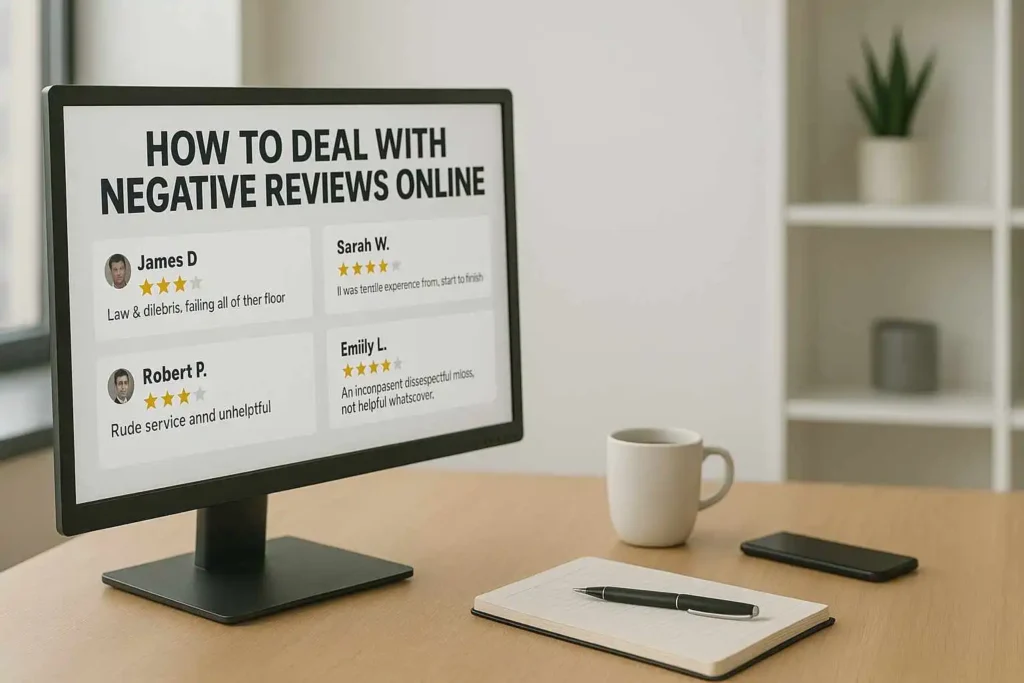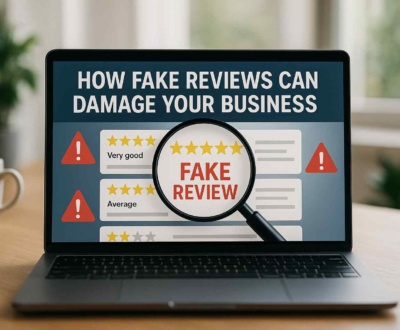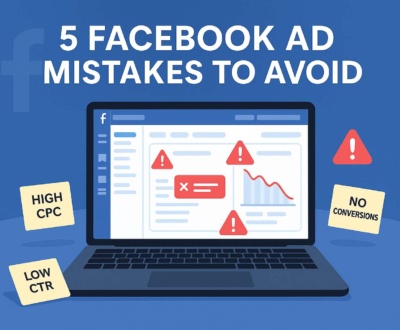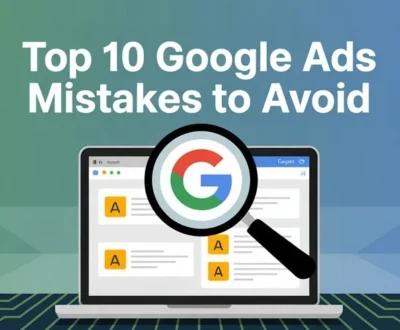How To Deal With Negative Reviews Online: A Complete Guide for Businesses
- July 7, 2025
- Online Reputation Management

Negative reviews can be frustrating, disappointing, and even scary. They might feel like personal attacks or unjust criticism, especially if you’ve worked hard to build your business. However, the reality is that every business receives negative reviews at some point.
What matters is how you respond.
How you handle negative feedback online can either strengthen or damage your reputation. Responding the right way can even turn unhappy customers into loyal ones.
This comprehensive guide will walk you through the process of handling negative online reviews, step by step.
What Are Negative Online Reviews?
Negative reviews are comments or ratings from customers who were not satisfied with your product, service, or experience. These reviews appear on platforms like:
- Yelp
- TripAdvisor
- Amazon
- Trustpilot
They often include complaints about poor service, bad experiences, delays, low-quality products, or unmet expectations.
Why Negative Reviews Matter
Some business owners ignore negative reviews, thinking they don’t matter. That’s a big mistake.
Here’s why they matter:
- They influence buying decisions: Over 90% of consumers read reviews before making a purchase.
- They affect your online reputation: A few bad reviews without a proper response can scare away new customers.
- They highlight problems in your business: Many reviews include useful feedback you can learn from.
Ignoring them doesn’t make them go away. Responding with care can improve your brand image.
Who Needs This Guide?
This guide is for:
- Small business owners
- Customer service managers
- Marketing professionals
- E-commerce sellers
- Anyone responsible for managing a business’s online presence
Whether you’re new to reviews or already have some experience, this article will help you build a smarter review strategy.
10 Practical Steps to Deal with Negative Reviews Online
1. Don’t React Emotionally
When you first read a bad review, your instinct may be to defend yourself. You might even feel angry or insulted.
Take a deep breath.
Here’s what to do first:
- Wait a few hours before responding.
- Reread the review to fully understand the complaint.
- Assume the customer’s perspective. Even if the review seems unfair, something caused them to feel that way.
Your goal is not to win an argument. It’s to show other customers that you care and act professionally.
2. Respond Quickly (But Thoughtfully)
Speed matters. Customers expect timely responses to their feedback.
According to a survey, more than 50% of customers expect a response within a few days, and some within 24 hours.
But speed should never come at the cost of quality. Think before you type.
Tips:
- Aim to respond within 1–2 business days.
- Don’t rush. Write a professional, calm, and thoughtful response.
- Respond on the same platform where the review was posted.
3. Personalize Your Response
Avoid copying and pasting the same reply to every negative review. It looks lazy and robotic.
Instead:
- Use the customer’s name if available.
- Refer to the specific issue they mentioned.
- Show genuine concern.
Example:
“Hi Jessica, thank you for sharing your experience. I’m very sorry to hear about the long wait time you experienced at our restaurant last weekend. That’s not the level of service we aim for.”
This shows the reviewer—and other readers—that you’re listening.
4. Apologize Sincerely
Even if you believe the customer is wrong, it’s smart to apologize for their experience. This doesn’t mean you admit guilt. It simply shows empathy.
Good examples:
- “I’m sorry that your experience didn’t meet expectations.”
- “We truly regret the inconvenience caused.”
- “It’s disappointing to hear that you had this issue with our product.”
Avoid defensive phrases like:
- “That’s not our fault.”
- “No one else has complained.”
- “You must have misunderstood.”
These make you look unprofessional and dismissive.
5. Offer to Make It Right
After apologizing, offer a solution if possible. People don’t just want to complain—they want a resolution.
Depending on the issue, you could:
- Offer a refund
- Replace a product
- Provide a discount or coupon
- Invite them back for a better experience
- Explain how you’re fixing the problem
Example:
“We’d love the chance to make it up to you. Please email us at support@example.com so we can send a replacement product at no charge.”
Even if they don’t respond, others will see that you tried.
6. Take the Conversation Offline
If a review involves a complex or sensitive issue, it’s better to continue the conversation in private.
Why?
- It prevents public arguments.
- It allows for more detailed discussion.
- It shows professionalism.
Say something like:
“We take your concerns seriously and would appreciate the chance to speak directly. Please reach out to us at [email] or [phone number].”
Make sure your contact info is active and that someone responds.
7. Learn from the Feedback
Don’t just fix one customer’s issue—look for patterns. If you keep getting similar complaints, it may be a sign of a bigger problem.
Example:
- If multiple people mention rude staff, you may need training.
- If many say shipping takes too long, it may be time to review your logistics provider.
Negative reviews can become a valuable business tool if you use them to improve.
8. Ask the Reviewer to Update Their Review
Once you’ve solved the customer’s issue, it’s perfectly okay to politely ask them to update their review.
Say something like:
“We’re glad we were able to resolve the problem. If you feel your experience has improved, we’d be grateful if you’d consider updating your review.”
Many customers are happy to do so, especially when they feel heard and respected.
9. Encourage More Positive Reviews
The best way to balance out negative reviews is to collect more positive ones.
After a good experience, ask satisfied customers to leave a review. You can:
- Add review links in emails
- Use a review request form after purchase
- Ask customers in person (politely)
The more positive reviews you have, the less impact one or two negative ones will have.
10. Handle Fake or Abusive Reviews the Right Way
Unfortunately, not all reviews are honest. Some may be:
- Left by competitors
- Written by bots
- Based on events that never happened
What you can do:
- Report the review to the platform (Google, Yelp, etc.)
- Flag it as inappropriate or misleading
- Contact the site’s support team with evidence
Most platforms have policies against fake reviews, but removal isn’t guaranteed. In some cases, your best bet is to respond calmly and clarify the situation for other readers.
Frequently Asked Questions
1. Should I respond to every negative review?
Yes, it’s recommended to respond to all negative reviews. This shows that your business is attentive and values customer feedback. Even if the reviewer doesn’t respond, your reply can influence future potential customers who read it.
2. What if the negative review is fake or from a competitor?
If you believe a review is fake or violates platform policies, report it to the review site (like Google, Yelp, or Facebook). Provide any evidence that supports your claim. Still, consider posting a polite and factual response so readers know your side of the story.
3. Can I delete a negative review from Google or Yelp?
You cannot delete reviews yourself. However, you can flag reviews that are inappropriate, spammy, or violate guidelines. The platform will then evaluate and decide whether to remove it. Legitimate reviews, even if negative, usually stay up.
4. How quickly should I respond to a negative review?
Ideally, you should respond within 24–48 hours. A prompt reply shows you’re actively engaged with your customers and serious about resolving issues. Avoid rushing if emotions are high—take time to write a clear and thoughtful response.
5. What if the customer is wrong or being unreasonable?
Even if you disagree with the review, respond politely and professionally. Acknowledge their feelings without arguing. Focus on resolving the issue rather than proving who’s right. Your tone matters more than the details when future customers read your reply.
6. How can I get more positive reviews to balance out the negative ones?
Encourage happy customers to leave reviews by:
Asking after a successful purchase or service
Including links in emails or receipts
Using follow-up messages
Making the process easy and quick
The more positive feedback you collect, the less impact a few negative reviews will have.
Conclusion
Dealing with negative reviews online may feel stressful, but it doesn’t have to damage your business. When handled correctly, a negative review can become a powerful opportunity to showcase your customer service skills, build trust, and improve your operations.
The key is to respond calmly, professionally, and with a genuine desire to solve the issue. Whether you’re addressing a real complaint or managing a fake review, your public response matters just as much—if not more—than the review itself.
Every review, positive or negative, is a chance to build your brand’s reputation. Use these moments to show your integrity, commitment, and willingness to improve. Over time, your thoughtful responses will speak louder than a single bad experience ever could.
Ready to Improve Your Online Reputation?
Negative reviews don’t have to hurt your business. With the right strategy, you can turn feedback into growth and build trust with future customers.
If managing reviews feels overwhelming, we’re here to help.
Our online reputation management services make it easy to monitor, respond to, and improve your reviews across all major platforms.
Let’s protect your brand and grow your reputation—together.
About us and this blog
We are a digital marketing company with a focus on helping our customers achieve great results across several key areas.
Request a free quote
We offer professional SEO services that help websites increase their organic search score drastically in order to compete for the highest rankings even when it comes to highly competitive keywords.








